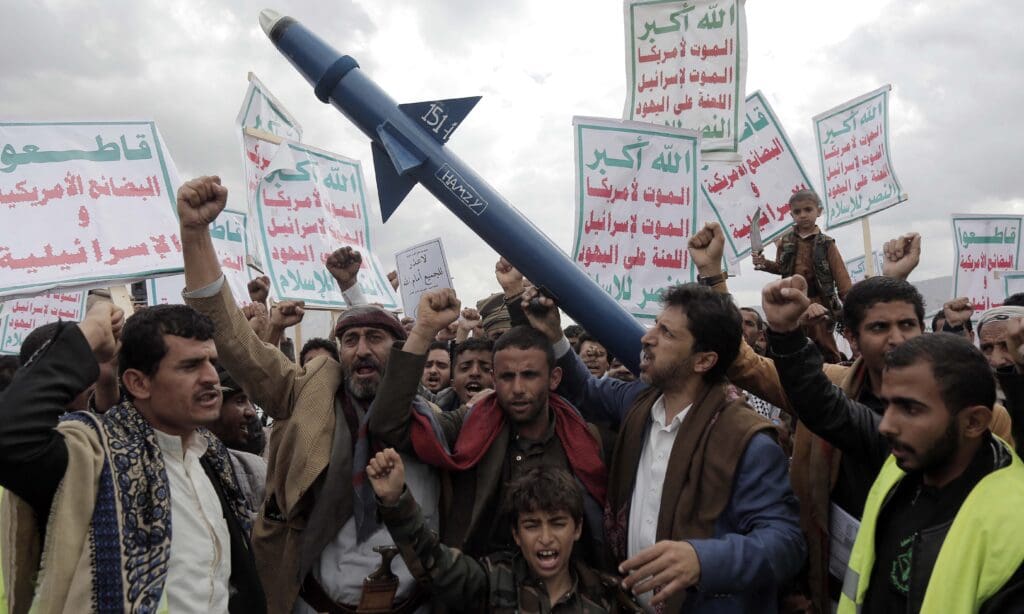Since October, the Middle East has edged ever closer to a regional war unlike any it has experienced before. While there has been plenty of armed hostility over the past 75 years, including between multiple state and non-state actors, the ambit of conflict this time around is so sweeping that it risks engulfing the entire region, making it both unprecedented and infinitely more dangerous.
Although the current unrest is inextricably linked to Israel’s ongoing destruction of the Gaza Strip, flashpoints have opened in distant places from southern Lebanon to the Red Sea. An escalating military confrontation between the United States and militias in Iraq and Syria has put those two countries, already devastated by decades of previous wars, on the frontlines of yet another.
Ironically, few actors appear to want a full-scale regional conflagration. Yet momentum is still building, primarily due to the misguided approach of Washington, which continues to fan the source of the conflict—Israel’s onslaught of Gaza—while attempting to fight fires elsewhere in the region with military force.
Anatomy of a Regional War
On October 7, Hamas initiated an attack on Israel that killed roughly 375 military and security personnel and massacred 600-700 civilians, as well as captured 240 hostages, both civilian and military. Israel responded with a total war and siege on the Gaza Strip. Over the ensuing months, as the carnage has spiraled to unimaginable levels, other parties have been drawn into the fray.
First and foremost is the U.S., which within days sent two aircraft carriers to the Eastern Mediterranean. It said this was to deter other actors from attacking Israel as it set about eliminating Hamas. Primarily, that meant Lebanon’s Hizballah, which almost immediately opened a mid-intensity front on the Lebanon-Israel border that continues to threaten a major escalation.
However, by extending unconditional military and intelligence support, financial aid, arms, and diplomatic cover to Israel, the U.S. has enabled and prolonged its ally’s devastating assault against Gaza and its people—which the International Court of Justice has ruled is plausibly a genocide in the making—and provoked a wider escalation in the region.
Moreover, the U.S. has put its military in direct confrontation with the so-called axis of resistance, an alignment of groups across the region affiliated to or backed by Iran. As public outrage has soared over Israel’s daily atrocities against the Palestinians, those forces have intervened in various ways, raising both the stakes for the region and the costs of America’s blanket support for Israel.
By opening a front on the Lebanese border, for instance, Hizballah forced Israel to evacuate most of its northern population centers and divert significant military resources there. In November, the Yemen-based Houthi movement began targeting commercial ships purportedly linked to Israel in the Red Sea, threatening a key global trade route and prompting the U.S. to mount a naval response. Iran-backed militia groups in Iraq and Syria also significantly intensified their long-running harassment of U.S. military installations in both countries.
In each of these areas, important local dynamics are being disrupted, including negotiations over a Lebanese president, discussions between the Iraqi government and the U.S.-led coalition over its future in the country, and peace talks in Yemen aimed at ending an 8-year war.
While the U.S. and its allies have tried to portray these flashpoints as somehow disconnected from Israel’s military campaign, that is not how it is seen in the region, and resistance forces have insisted they will only back down after a ceasefire in Gaza.
The Importance of Public Opinion
Since October 7, anger and resentment have surged over Israel’s actions in Gaza and the West’s decision to underwrite them. This is consequential for several reasons, including the effect of public perceptions on the legitimacy of the U.S., Israel, and the Arab states aligned with them. Perhaps most importantly for the war itself, it incentivizes forces already ideologically committed to resistance against the U.S. and Israel. This makes it highly unlikely that they will be deterred by U.S. military actions.
Undoubtedly, the standing of the U.S. has been severely damaged. A poll in December and January across 16 Arab countries by the Doha-based Arab Center found 94% of respondents had a negative view of Washington’s response to the Israeli war on Gaza.
These sentiments extend to America’s regional allies, who are seen as doing little to defend Gaza, especially compared to Iranian-linked forces. That is significant considering the longstanding rivalry between these camps in a competition for regional influence.
According to an Arab Barometer poll in Tunisia—seen as a regional bellwether—conducted in the weeks before and after October 7, “every country in the survey with positive or warming relations with Israel saw its favorability ratings decline,” while those of Iran’s leadership rose. Iranian Supreme Leader Ali Khamanei’s popularity matched or surpassed those of the leaders of Saudi Arabia and the United Arab Emirates. In the Arab Center poll, 50% of people surveyed viewed Iran’s response to Israel’s war in Gaza positively, the most of any country tested. The UAE, on the other hand, was viewed positively by only 20%, while Saudi Arabia performed only slightly better.
In this climate, it is unsurprising that America’s regional partners have distanced themselves since October 7, and are even coordinating with Iran to prevent a wider escalation. Some are restricting the U.S. from using military facilities on their soil to launch strikes against axis of resistance forces. When the U.S. mobilized a coalition against the Houthis, only Bahrain joined, despite the impact on the entire region’s economies. Not only are regional states eager to avoid being seen as providing cover for Israel, but they are afraid of joining U.S. forces as a target of the resistance axis. This leaves the U.S. and other Western powers deeply isolated in the region.
Washington’s Failed Deterrence Strategy
It is logical that America feels compelled to respond to disruptions in global commerce or attacks on its military and intelligence installations. But against the larger backdrop of the genocide in Gaza, its efforts to stamp out regional unrest militarily while aiding and abetting Israeli war crimes are only likely to enflame the situation. Regardless of how the U.S. views itself, the region sees it as complicit in a grave crime, providing a casus belli for attacks on U.S. troops.
This means it is highly unlikely to achieve deterrence. First, resistance forces have won growing popularity and legitimacy for standing up to the U.S. and Israel. The Houthis, for example, were a relatively obscure and marginal player in regional affairs prior to October 7. Since launching operations in the Red Sea under the banner of defending Palestinians, they have been catapulted into the limelight with newfound prominence regionally and globally.
Secondly, Iran and its allies are strategically committed to pushing the U.S. out of the region in the long term. U.S. military actions within the framework of the war in Gaza provide an opportunity and arena to advance this goal, given widespread outrage against the U.S.
Finally, the resistance forces know that Washington is averse to another major military engagement in the Middle East after decades of fruitless conflict. They calculate that they are unlikely to face a full-scale confrontation with the U.S. military, something they too are seeking to avoid. A limited campaign of targeted U.S. strikes is tolerable and unlikely to force a capitulation.
Biden has admitted as much. When asked by a journalist in January if U.S. strikes on Houthi positions in Yemen were working, Biden responded: “When you say working, are they stopping the Houthis? No. Are they going to continue? Yes.” This simple statement illustrates both the dilemma and the recklessness of the current American policy.
The result has been a precarious dance in which both sides are using deadly force while trying not to trigger a full-scale war. Yet with so many actors involved on so many fronts, the possibility of grave escalation is only a misstep away.
As Gaza Burns
The only actors who plausibly want a broader escalation are Benjamin Netanyahu and the far-right ministers in his cabinet. Severely discredited by Hamas’ October 7 attack, the Israeli prime minister has an interest in extending the war as long as possible to avoid a reckoning with the public over his failures. Through that lens, one can view recent Israeli assassinations of hostile figures in Lebanon and Syria as designed to provoke an escalation and even entangle the U.S. military, which has become the target of retaliation.
In the longer term, however, Netanyahu’s only chance for political survival—something he covets above all things—is to redeem himself in the eyes of his public. It is highly plausible that Netanyahu believes redemption can be had by relieving Israel of a decades-old source of vexation and violence—the Gaza Strip. To that end, Israel’s military campaign appears directed towards liquidating the enclave. This has already produced immeasurable suffering for Palestinians, which will reverberate for a very long time. But it is also deeply destabilizing for the region, even beyond the immediate threat of a broader war.
Along the border with Gaza, Egypt fears Israel may seek to depopulate the territory by foisting millions of its residents onto the Sinai Peninsula. Jordan, too, with millions of Palestinians already within its borders, is anxious over what Israeli actions in Gaza and the West Bank mean for stability at home.
When something similar to this moment happened in 1948, it created generational volatility in the region: wars and coups d’état, radicalism and terrorism, and the concretization of state security over freedom and democracy.
As long as Israel continues down its current path, outrage will grow across the region. The only conceivable way to avoid regional war in the near term, and mitigate the consequences further down the line, is to halt Israel’s genocidal campaign in Gaza and address the Palestinian question of self-determination in earnest. For the time being, however, military solutions seem to be all that’s on the table.
The opinions expressed in this article are those of the author and do not necessarily reflect the views of the Middle East Council on Global Affairs.


